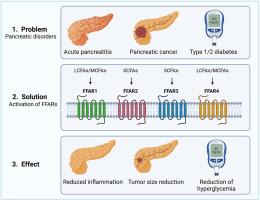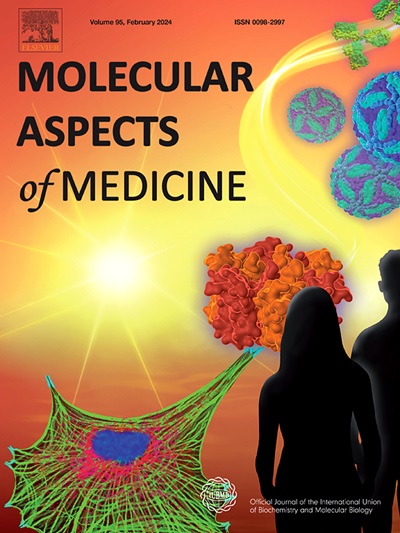The role of free fatty acid receptors activation in pancreatic disorders
IF 10.3
2区 医学
Q1 BIOCHEMISTRY & MOLECULAR BIOLOGY
引用次数: 0
Abstract
Free fatty acid receptors (FFARs), a subset of G protein-coupled receptors, play a pivotal role in metabolic and immune homeostasis by modulating signaling pathways in response to free fatty acids. The four main FFARs (FFAR1, FFAR2, FFAR3, and FFAR4) are especially significant in pancreatic function, regulating insulin secretion, inflammation, and glucose metabolism. These receptors are involved in key pancreatic disorders, including acute pancreatitis (AP), pancreatic cancer (PC), type 1 diabetes (T1D), and type 2 diabetes (T2D).
FFAR1, FFAR3, and FFAR4 exhibit protective effects against AP due to their anti-inflammatory properties. In PC, FFAR1 inhibits tumor cell motility, while FFAR2 downregulation may contribute to tumor progression. FFAR3 plays a role in limiting tumor proliferation, whereas FFAR4 has a dual effect, promoting metastasis while also triggering tumor cell apoptosis. In T1D, FFAR2 and FFAR4 help regulate glycemia without directly stimulating insulin secretion. In T2D, all four FFARs contribute to glycemic control and may protect pancreatic β-cells.
Despite their therapeutic potential, the precise mechanisms underlying FFAR function in pancreatic disorders remain incompletely understood. Ongoing research aims to clarify these pathways, identify optimal ligands, and assess the safety and efficacy of FFAR-targeted therapies. This growing body of evidence underscores the importance of FFARs as potential targets for innovative treatments in pancreatic diseases.

游离脂肪酸受体激活在胰腺疾病中的作用
游离脂肪酸受体(FFARs)是G蛋白偶联受体的一个子集,通过调节游离脂肪酸应答的信号通路,在代谢和免疫稳态中发挥关键作用。四种主要FFARs (FFAR1、FFAR2、FFAR3和FFAR4)在胰腺功能、调节胰岛素分泌、炎症和葡萄糖代谢中尤为重要。这些受体参与关键胰腺疾病,包括急性胰腺炎(AP)、胰腺癌(PC)、1型糖尿病(T1D)和2型糖尿病(T2D)。FFAR1、FFAR3和FFAR4由于其抗炎特性对AP表现出保护作用。在PC中,FFAR1抑制肿瘤细胞运动,而FFAR2下调可能促进肿瘤进展。FFAR3发挥限制肿瘤增殖的作用,而FFAR4具有双重作用,既促进肿瘤转移,又触发肿瘤细胞凋亡。在T1D中,FFAR2和FFAR4在不直接刺激胰岛素分泌的情况下帮助调节血糖。在T2D中,所有四种ffar都有助于血糖控制,并可能保护胰腺β细胞。尽管具有治疗潜力,但FFAR在胰腺疾病中功能的确切机制仍不完全清楚。正在进行的研究旨在阐明这些途径,确定最佳配体,并评估ffar靶向治疗的安全性和有效性。越来越多的证据强调了FFARs作为胰腺疾病创新治疗的潜在靶点的重要性。
本文章由计算机程序翻译,如有差异,请以英文原文为准。
求助全文
约1分钟内获得全文
求助全文
来源期刊

Molecular Aspects of Medicine
医学-生化与分子生物学
CiteScore
18.20
自引率
0.00%
发文量
85
审稿时长
55 days
期刊介绍:
Molecular Aspects of Medicine is a review journal that serves as an official publication of the International Union of Biochemistry and Molecular Biology. It caters to physicians and biomedical scientists and aims to bridge the gap between these two fields. The journal encourages practicing clinical scientists to contribute by providing extended reviews on the molecular aspects of a specific medical field. These articles are written in a way that appeals to both doctors who may struggle with basic science and basic scientists who may have limited awareness of clinical practice issues. The journal covers a wide range of medical topics to showcase the molecular insights gained from basic science and highlight the challenging problems that medicine presents to the scientific community.
 求助内容:
求助内容: 应助结果提醒方式:
应助结果提醒方式:


